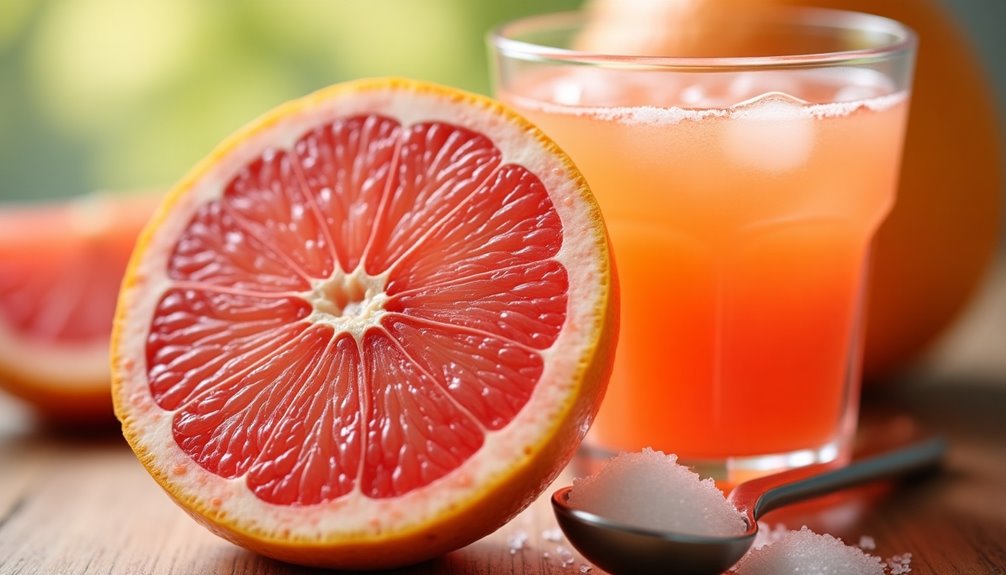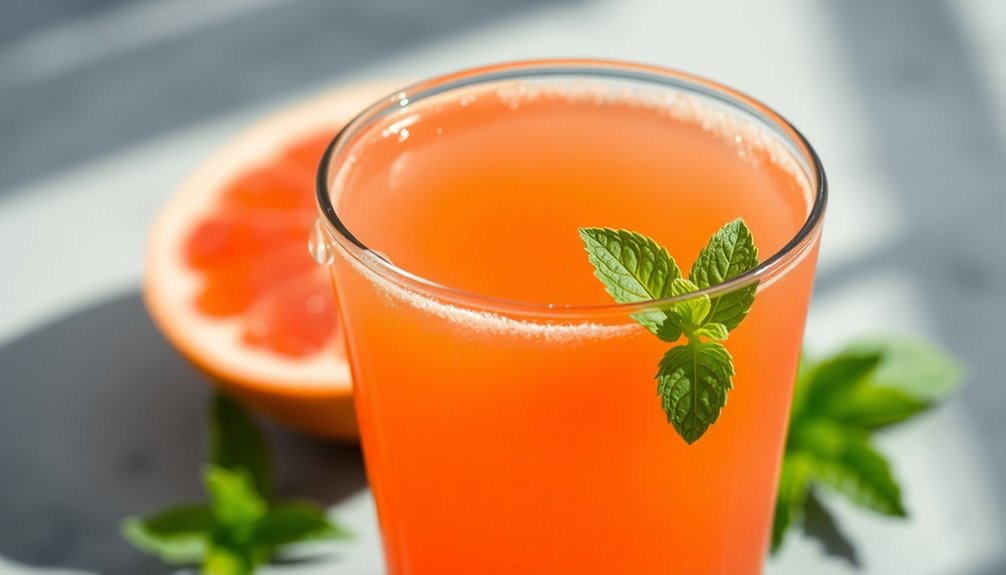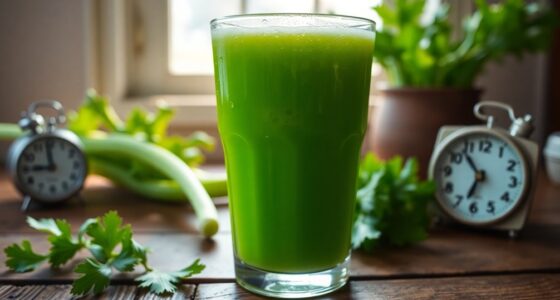Grapefruit juice contains about 22 grams of sugar per cup, mainly from naturally occurring fructose. This sugar makes up around 92% of the juice’s total macronutrients. While it’s a low-calorie beverage, with about 90 calories per serving, it’s essential to monitor your sugar intake if you’re health-conscious. Enjoy it in moderation, ideally paired with high-fiber or protein-rich foods. There’s more to discover about its nutritional benefits and potential health properties too. In addition to its delicious flavor, grapefruit juice is rich in vitamins and antioxidants that can support overall wellness. However, it’s crucial to consider how much sugar in grapefruit juice may impact your daily dietary goals, especially for those managing blood sugar levels. Balancing its consumption with other nutritious foods can enhance its health benefits while keeping your sugar intake in check.
Key Takeaways
- One cup of grapefruit juice contains 22 grams of sugar, primarily from naturally occurring fructose.
- The sugar in grapefruit juice makes up about 92% of its total macronutrients.
- Grapefruit juice has no added sugars or artificial sweeteners, maintaining its natural sweetness.
- Although it has a high sugar content, grapefruit juice is low in calories, with about 90 calories per serving.
- Moderation is key, as occasional consumption can provide health benefits while managing sugar intake effectively.

Wondering how much sugar is in grapefruit juice? If you're considering adding this refreshing drink to your diet, it's essential to know that one cup of grapefruit juice contains 22 grams of sugar. This total carbohydrate content primarily comes from naturally occurring sugars, mainly fructose, which gives the juice its sweet flavor. Unlike many beverages on the market today, grapefruit juice doesn't contain added sugars or artificial sweeteners, making it a more natural choice for those looking to stay healthy.
While the sugar content may seem high, it's important to put it into perspective. Grapefruit juice is low in calories, with about 90 calories per serving. That makes it a popular option for health-conscious consumers who want to enjoy a flavorful drink without overloading on calories. The sugar in grapefruit juice accounts for approximately 92% of its total macronutrients. This means that if you're watching your sugar intake, it's something to keep in mind, but it also highlights the juice's natural sweetness.
Aside from sugar, grapefruit juice packs a punch when it comes to nutrients. It's rich in vitamin C, which is vital for your immune system and overall health. Just a single serving can contribute significantly toward your Daily Value of vitamin C, helping you meet your nutritional needs while enjoying something tasty. With all the benefits, the natural sugars found in grapefruit juice can be a part of a balanced diet.
If you're someone who monitors your sugar intake closely, you might wonder how grapefruit juice fits into your meal plan. The key is moderation. Enjoying a cup of grapefruit juice occasionally can provide refreshing flavor and health benefits without pushing your sugar consumption to unhealthy levels. Pair it with high-fiber foods or protein to balance out the sugar content and create a satisfying meal or snack.
It's also worth noting that, while grapefruit juice has a high sugar content, it's often favored for its potential health benefits. Studies suggest that grapefruit juice may have properties that help with weight management and cholesterol levels. With its unique combination of flavors and nutrients, it's no wonder that many people find grapefruit juice appealing.
Frequently Asked Questions
Is There a Lot of Sugar in Grapefruit Juice?
You might wonder if there's a lot of sugar in grapefruit juice.
While it does contain natural sugars, it's not excessive compared to many other beverages.
With just 22 grams of sugar per cup, it remains lower in calories and has a lower glycemic index.
This means you can enjoy its refreshing taste without worrying too much about sugar spikes.
Plus, it's a healthier choice since it doesn't have added sugars.
Can Diabetics Drink Grapefruit Juice?
Yes, you can drink grapefruit juice if you're diabetic, but moderation is key.
Since it contains sugar, you should monitor your portion sizes to manage your blood sugar levels effectively. Keep an eye on your overall carbohydrate intake, as that sugar counts towards your daily limit.
Also, grapefruit can interact with certain diabetes medications, so it's wise to consult your healthcare provider before adding it to your diet.
Enjoy its benefits responsibly!
Which Has More Sugar Orange Juice or Grapefruit Juice?
Imagine standing at a crossroads between two orchards, each offering a sweet nectar.
If you choose orange juice, you'll find about 21 grams of sugar per cup, while grapefruit juice greets you with around 22 grams.
So, grapefruit juice has a smidge more sugar.
Both juices are natural delights, bursting with vitamins; just remember, moderation is key to enjoying the bounty of these refreshing fruits without worry.
Is It Okay to Drink Grapefruit Juice Every Day?
Yes, it's generally okay to drink grapefruit juice every day, as long as you don't have any specific health concerns or medication interactions.
The juice offers excellent benefits, like a boost of vitamin C and potassium, while being low in calories.
Just be sure to check with your healthcare provider if you're on medication, since grapefruit juice can affect how some drugs work.
Enjoy it in moderation for the best results!
Conclusion
In the end, understanding the sugar content in grapefruit juice can help you make healthier choices. While it's naturally low in sugar compared to other juices, moderation is key. Think of it this way: enjoying a glass of grapefruit juice is like savoring a sweet moment in your day—too much can spoil the experience. So, relish it wisely, and let the refreshing taste elevate your routine without overindulging in sugar. Your body will thank you!
Cindy thoroughly researches juicing trends, techniques, and recipes to provide readers with practical advice and inspiration. Her writing style is accessible, engaging, and designed to make complex concepts easy to understand. Cindy’s dedication to promoting the advantages of juicing shines through her work, empowering readers to make positive changes in their lives through the simple act of juicing.

















